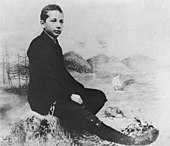Max Talmey
Max Talmey (born Max Talmud; Yiddish: מאַקס טַלמוּד; 1869 – November 7, 1941)[2] was a Lithuanian-born American ophthalmologist and educator of Jewish descent,[3] best known as Albert Einstein's tutor who introduced him to fields of and books on natural science and philosophy, for his success in treating cataracts, and for his work on auxiliary languages.
They used to discuss themes of interest to Albert Einstein, and Talmey lent him a number of books about science, including works on general science like multi-volume Popular Book on Natural Science by Aaron Bernstein, works on physics like Force and Matter by Ludwig Buchner, on mathematics like Theodore Spieker's popular textbook on geometry for higher schools (Lehrbuch der ebenen Geometrie mit Übungsaufgaben für höhere Lehranstalten - Th.
Spieker 1899/289), which was based on classic Euclid's Elements, and which he called "his holly little geometry book";[10][11][12] and philosophy, like The Critique of Pure Reason by Immanuel Kant.
[1] Many of those books were considered leading sources on their subjects, and at each meeting Einstein showed his mentor some of the problems he had solved that week.
As Talmey recalled, teenage Einstein soon surpassed his mentor in mathematics and physics, and their discussions moved to philosophy.
Talmey said that Albert "became so interested in mathematics and physics that he took a profound dislike for the methods of the school, concluded his studies were wasted there and devoted himself to self-education.
One set was Popular Books on Natural Science by Aaron Bernstein, which describe light, distance, astronomy, meteorology, and nutrition.
His popular book, Love, A Treatise on the Science of Sex-Attraction for the Use of Physicians and Students of Medical Jurisprudence, went through ten editions.
[1]As with young Einstein Talmey's interests in medicine during his studies were broad; he then for a time also considered specializing in psychiatry.
In New York, Max Talmey first had a general practice, including otorhinolaryngology and related work, and also got published a textbook intended for medical and law students on psychology and psychiatry, the area that was not well covered at the time.
He published papers on an ophthalmic topics, such as cataract surgery, corneal burns, and the differential diagnosis of optic neuritis.
His 1905 attack on other ophthalmologists is entitled "Reflections concerning pretended therapeutic successes obtained by some practitioners of the ophthalmological specialty".
Talmey wrote "Certain devotees of ophthalmology surpass those of any other specialty with their wonderful therapeutic achievements by the most simple means.
In some instances the simplicity of the remedy for the cure of obstinate diseases that have baffled the skill of the internist and neurologist, is nothing short of marvelous".
As a result, the standard procedure was changed that year so tonsillectomies were no longer performed in the summer when most cases of polio developed.
[15] Talmey thought that Esperanto was flawed: In a letter to the editor of the New York Times, he described some of the problems of universal languages.
Nia skopo, sub fortunoza auspicii, es sikurigar la continuations dil prospero di paco."
Its description reads: "In Gloro there are 18 suffix forms to denote different parts of speech, verb tenses, case endings.


